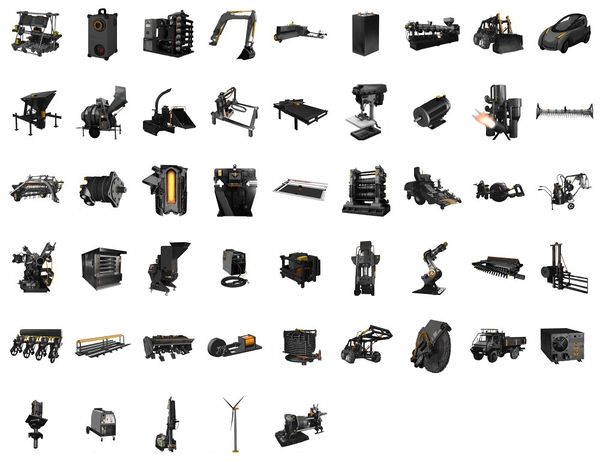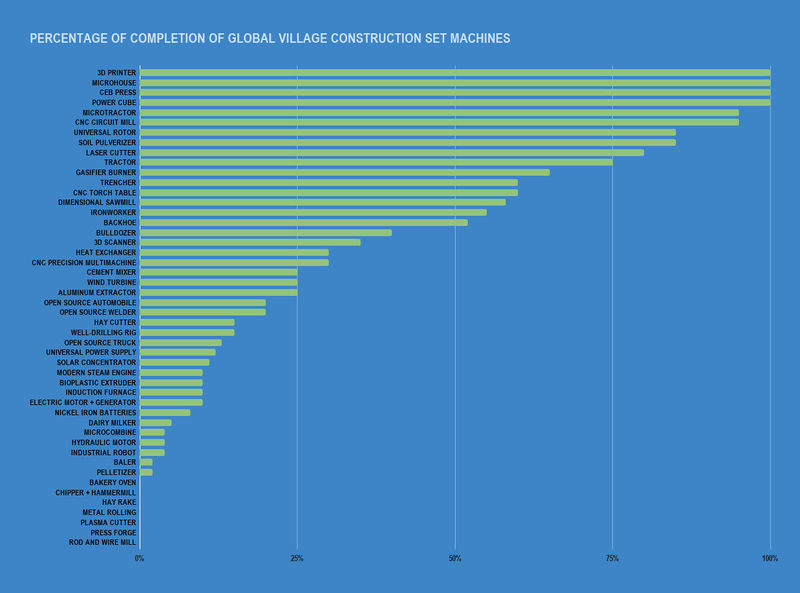Global Village Construction Set
| OSE Required Reading | |||
|---|---|---|---|
| Wiki instructions · Crash course on OSE · Global Village Construction Set · Getting Started Guide · Team Culturing · Version control - Genealogies | |||
Definition
The Global Village Construction Set (GVCS) is a modular, DIY, low-cost set of blueprints that enables fabrication of the 50 different Industrial Machines that it takes to build a small, sustainable civilization with modern comforts. The name, GVCS, has been coined for the first time in 2008 - at a lecture at the University of Missouri, Columbia - see UM Presentation.
End State
The above paragraph is a brief summary, but the goals of the GVCS are much larger. In 2019, our Vision has been reframed to collaborative design for a transparent and inclusive economy of abundance. THe GVCS remains at the center of that. However, one cannot build sound technology without building sound people. Open, transparent collaboration includes developing the human aspect - in terms of soft skills to collaborate, be vulnerable, have self-esteem, have a growth mindset - the soft requirements for any supercooperator. OSE strives to produce Integrated Humans who have both the hard and soft skills to make a better world - as movement entrepreneurs whose life is relevant to solving pressing world issues.
Currently there are several, outstanding, unconscionable aspects of civilization: continuing ecocide, war, consumerism, poverty, poor distribution of wealth or access, ignorance. The world has improved to more liberty for more people, but many are left behind. These are easily solvable by taking on a fundamental approach, such as planting trees, open-sourcing the economy, and learning to grow as humans. These solutions are very easy and very hard at the same time.
At the core, OSE's work requires human evolution for a transition from a proprietary, military economy - to a collaborative economy.
With great power comes great responsibility. Economy of abundance in our vision statement is a rigorous requirement that implies wisdom towards efficient production of basic needs, as a basis for Self-Determination.
When exactly do we say that the Global Village Construction Set is commplete - that we have succeeded? It is when:
- Anyone has access to build any product anywhere in an open source microfactory, which is powered by a repository of global, collaborative design and open source production tools. This means that any place in the world has a realistic capacity to create a modern economy if it chooses to do so, without having to make compromises of a typical Technology Colony.
- All infrastructure-building tools to start villages, microstates, farms, factories, civil works, land restoration operations, and any other human infrastructure - can be built at low cost using best-practice, open source techniques and equipment.
- Hundreds of land-based, OSE facilies are built around the world - as land-based campuses somewhat like a university campus - which are fully regenerative global villages that thrive in harmony with their natural life support systems. These are places of real life, learning, and activism - with an explicit purpose of solving pressing world issues. Imagine going to college, where as a result - you end up not as a quant or symbolic analyst in a cubicle - but as a hands-on builder of a new world: a person who leaves college pursuing solutions to pressing world issues, and getting involved in a full time-effort of such transformation. Why the OSE campuses? Because sometimes transformative work has no money in it. The status quo does not pay changemekers to subvert itself. So the OSE Campus is a facility where people contribute 2 hours of work per day
- Numbers-wise, Distributed Market Substitution is growing as an exponential occurrence, with billions worth of markets already substituted on 3-year timescales.
- A large number of people are trained in open source product development - about 10% of all human enterprise across sectors (mining, manufacturing, governance, financial, agriculture, services). Open publishing is the norm.
- Modular, open source standards are common, such that planned obsolescence - as occurring by virtue of black-boxing, self-destruct parts, changed form factors, proprietary software, non-interchangeable parts, hard to find parts, expensive parts, design-for-non-disassembly, easily-breakable parts, inferior materials, and others - are design, and other bad design - is eliminated.
- All pressing world issues mentioned above are in significant decline, as general self-determination replaces current alienation.
Introduction
Marcin Jakubowski explains the Global Village Construction Set in his TED Talk.
Can't see the video below? Try: http://www.ted.com/talks/marcin_jakubowski.html
Want to know more? Explore the Global Village Construction Set tech tree.
Want to contribute? Sign up for OSEmail to get monthly updates.
Completion Status
See GVCS_State_of_Completion for the history of the completion status.
Prototypes - Visual Status
Items prototyped are in red. State in 2018.
Timeline
(needs updating since 2014 - see blog or [ FB] for updates.
The Open Source Ecology experiment was formulated in 2003. The practical experiment began on a 5 acre parcel on the outskirts of Madison, Wisconsin, USA. Networking with early collaborators, the project found its new home on a 20 acre parcel in Osborn, Missouri. In 2006, the project moved to its permanent location in Maysville, Missouri - to Factor e Farm - birthplace of the Global Village Construction Set.
Media
Key Features
See summary at OSE Specifications for Product Design.
|

|
GVCS Machines
See main article GVCS Machine
OSE is developing 50 machines of the Global Village Construction Set via module-based design. This means that we break machines down into modules, and each module can be developed in parallel with other modules. Examples are CEB Press or Tractor.
The exact list of GVCS machines has evolved over time and is still subject to change. For example, while the MicroHouse and the Car are not GVCS machines in a strict sense (but products created by GVCS machines), they are treated as GVCS machines for historical and business-oriented reasons.
Documentation is found at different places for different target groups:
- Graphical list of 50 machines on our main website (Public)
- Hierarchical representation of machines/modules at dozuki: http://opensourceecology.dozuki.com/ (Public, Prototypers, Developers)
- Wiki internal list of GVCS machines and their breakdown into modules - GVCS Machines and Modules and GVCS State of Completion (Prototypers, Developers)
